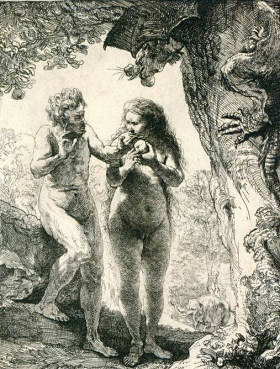Most people take for granted that a snake tempted Eve. This is due primarily to how most Bibles translate the Hebrew word Nachash (Strong's Concordance #H5175), which is used to designate the beast that led her to sin. The KJV and other versions of God's word such as the NKJV, NIV, NASB and JPS translate Nachash, found in Genesis 3, as "serpent." Other Bibles, like the CEV and TEV translations, state that she was lead astray by a "snake."
In modern English, both "snake" and "serpent" mean roughly the same thing. This creature is an elongated reptile that has no limbs and possesses scales. It journeys from place to place by moving its body along the ground. This short study will show that this animal, commonly believed to be the culprit that tempted Eve and bought "the fall of man," is NOT the same one described in the Bible!

The first verse of Genesis 3 introduces to us the "serpent" (snake) allowed in the Garden the Eden with the express purpose of testing the obedience of the first humans, especially Eve.
Now the serpent (Nachash) was more cunning than any creature of the field which the Lord God had made. And he said to the woman, "Is it true that God has said, 'You shall not eat of any tree of the garden?'" (Genesis 3:1, HBFV).
What does Genesis reveal to us about the unique beast that Satan possessed in order to deceive Eve? Was it really a snake? A straightforward reading of Genesis 2 and 3 reveals the following four facts about the Nachash.
It was an animal created by God (on the same day Adam and Eve were made!) that was declared "very good" (see Genesis 1:24 - 26, 3:1). It was even given a name by Adam (2:19 - 20).
It was made with a certain amount of reasoning ability ("it was more cunning than any creature . . .") that was above all other created beasts.
It could speak to Eve and had the necessary organs to allow it to do so.
It was able to walk erect and had (at the minimum) at least four limbs.
Original Traits
Concerning the Nachash's original traits, three popular Bible study tools state the following.
" . . . the woman no doubt having often seen him (the Nachash) walk erect, talk, and reason, and therefore she testifies no kind of surprise when he accosts her in the language related in the text . . ." (Adam Clarke's Commentary on Genesis 3:1).
"If these words are not to be robbed of their entire meaning, they cannot be understood in any other way than as denoting that the form and movements of the serpent (Nachash) were altered . . ." (Keil and Delitzsch Commentary on the Old Testament, comments on Genesis 3:14).
"Upon thy belly shalt thou go - No longer upon feet, or half erect, but thou shalt crawl along . . ." (John Wesley's Explanatory Notes, comments on Genesis 3:14).
As the above shows, whatever the Nachash was that deceived Eve, it certainly does not qualify as a snake or serpent as we know them today!
Why Not a Serpent?
The 17th century Renaissance painter Rembrandt, in his etching shown in this article, portrays a slightly more accurate Biblical scene of the temptation of man than the depiction at the top of this article. He shows an animal, with legs, tempting Eve. The animal is clearly not a snake.
So, why is the beast that tempted Eve not what we would call a snake but rather some beast with legs? Perhaps the most compelling reason is that if it was it would mean God's curse upon the beast would be meaningless!
The creature's punishment for tempting Eve to sin was that it would be cursed above livestock and animals of the field (which all have limbs!) by having its means of transporting itself changed to crawling on its belly (Genesis 3:14).
If the animal used to deceive Eve was a snake then the curse it received was redundant and meaningless, as it was already slithering on the ground to move!
If Eve was led to sin by a snake it would also mean that the Eternal originally created a "cursed" land animal (one which had to "go upon its belly" in order to move) when he made all creatures (Genesis 1:24 - 25). This was clearly not the case, as God declared all animals he made were "very good" (verses 21, 25), meaning "all livestock" and "every animal of the field" were not cursed in any way!
The beast that deceived Eve was not a snake. The Nachash Satan used had the natural ability to speak, had certain reasoning abilities, and could transport itself using its limbs. It was the perfect means (much like Judas Iscariot, Luke 22:3, John 13:2) to encourage disobedience and sin in humans.
The punishment the Nachash received for telling lies to Eve dramatically changed it from a walking, talking and reasoning creature to one that slithers, hisses and has only brute instinct. As such, this animal (as initially created by the hand of God) ceased to exist.